Sony VAIO SE: An IPS Laptop for Under a Grand
by Jarred Walton on April 3, 2012 5:40 PM ESTDouble Your Pleasure with a Sheet Battery
Battery life is good, which isn’t too surprising as Sandy Bridge laptops with switchable graphics have always delivered the goods. The wrinkle here is if you want to get the $150 sheet battery, you can double your battery life. As mentioned earlier, Sony also has some intelligent battery circuitry so that you’ll discharge/charge the sheet battery first, allowing you to put it away (or connect it to the separate charging station) and take the now lighter laptop with you.
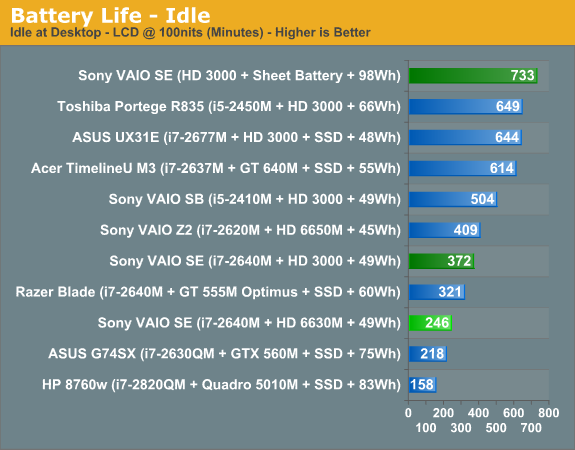
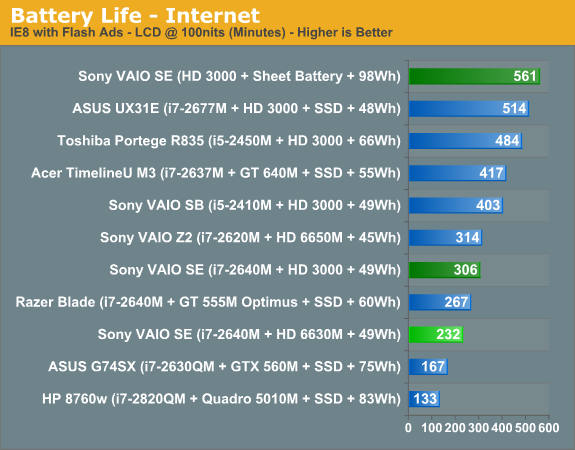
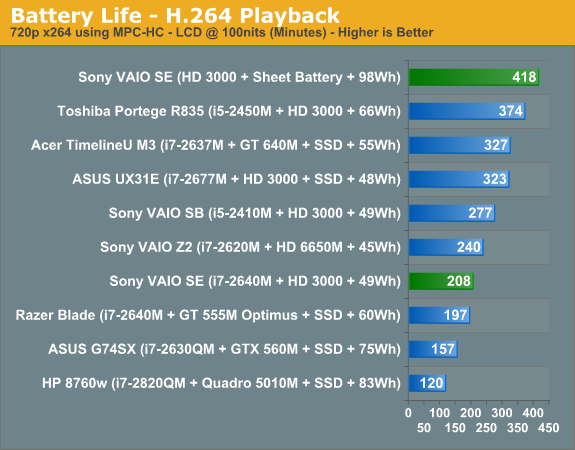

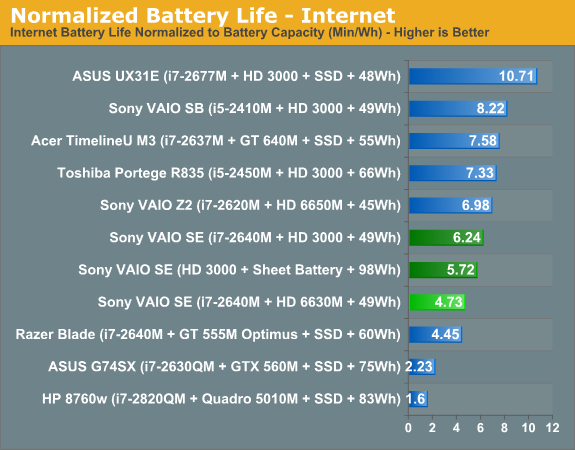
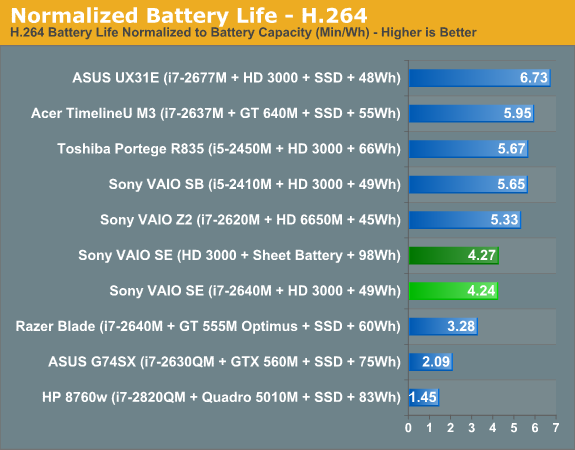
If we take the stock scores, battery life is similar to what we’ve come to expect from Sandy Bridge laptops. The integrated 49Wh battery actually delivers better battery life than some competing laptops with 56Wh batteries, but we’d take the reported battery capacity with a grain of salt as there’s certainly some wiggle room there. Even so, our normalized battery life charts show that Sony knows a thing or two about power optimizations. As for the sheet battery, it does more or less double the battery life—there’s some margin for error in our battery life tests and given the number of battery tests we already had to run we didn’t repeat most tests multiple times.
We also did a quick test of idle and Internet battery life with the discrete GPU enabled, just to see how much extra power that consumes. Based on the 49Wh battery capacity, the VAIO SE idles at around 7.75W and averages 9.41W during the Internet test while running off the IGP. Turn on the HD 6630M and idle power draw (on battery) increases to 11.71W while Internet power draw is 12.42W. Based on that it appears the HD 6630M has an idle power draw that’s around 4W more than the HD 3000, but for “typical” Internet use it only uses 3W more than the IGP.
We also tested dGPU battery life while playing games and still managed two hours of gaming with the main battery, but that was using the Balanced power profile with AMD’s PowerPlay set to Maximum Battery Life. Using those settings, we found that typical gaming performance dropped anywhere from 3% (Battlefield 3) to as much as 40% (Skyrim), with most titles showing a drop in frame rates of around 15-20%. Set PowerPlay to Maximum Performance and you’ll get full performance from the HD 6630M at the cost of battery life; our 122 minute result became 90 minutes with PowerPlay at Max Performance. Double that with the sheet battery, though, and you’re looking at roughly three hours of decent gaming performance while unplugged—something you’re not likely to exceed right now with any “gaming” laptop!
Thermals: Too Hot to Handle?
We mentioned earlier that we have concerns with the way the hinge and LCD pivot down to block the sole exhaust port on the back of the laptop. We never experienced any instability from the design, but one look at thermals under load should help you understand why we think the design is flawed:
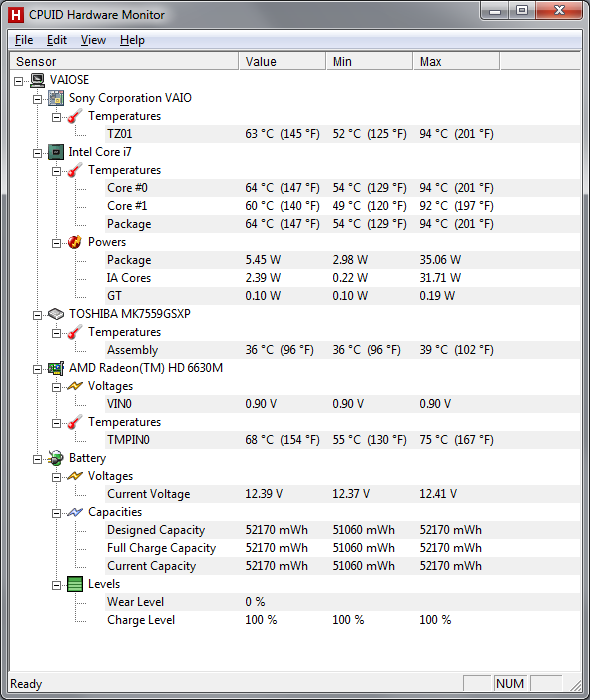
We’ve seen a few laptops run hotter than the VAIO SE under load—notably, the Toshiba Portege R835 ultraportable we just reviewed hits 100C on one of the cores during our stress tests—but 94C is still far more than we’d like. For an i7-2640M, this is the second laptop that might simply be “too thin” (the first being the Razer Blade that hit 95C). We’d really like to see max CPU thermals under 80C, even for thinner laptop designs. Long-term, the concern is that once you start to get some dust inside the fan and radiator, cooling performance will suffer and you’ll start to hit 100C or more. I recently saw this exact issue with a friend’s laptop (with an older Core 2 Duo T9550 CPU), which caused the laptop to get very hot to the touch and eventually shut off (with no warning) after heavy use.
Noise Levels
The high temperatures unfortunately have a secondary companion: noise pollution. At idle and under light loads, the VAIO SE is well behaved: we measured 31.2 dB from around 18” above and in front of the laptop (where your head would typically be if you’re using the laptop), and for many tasks the noise levels never broke 35 dB. All that starts to change when you put a heavy load on the system. For gaming, it really depends on the type of game you’re playing—specifically, how CPU intensive the game happens to be. 3DMark06 for instance never got about 36 dB in the graphics tests, but it tends to be pretty light on the CPU side of the fence. Batman: Arkham City and several other modern titles (Battlefield 3 and Skyrim) are a different story, with fan speeds apparently maxed out and noise levels hitting 46.7 dB—very similar to the Razer Blade, though I’d characterize the noise as being less annoying on the VAIO SE. The real culprit here is the CPU, though, as any heavy CPU load (video encoding, Cinebench, etc.) will peg the fan speed and noise at the same 46.7 dB.
For all the noise the fan generates, it doesn’t feel like it’s moving a lot of air, and this is where the hinge and the blocked exhaust port really makes its mark. It’s about what you’d get from other laptops if you stuck your hand in front of the exhaust and left it there. Provided you’re not planning on doing a lot of CPU intensive tasks, however, the VAIO SE isn’t all that noisy. For office applications and Internet browsing, I never had issues with the fan, and assuming you have a desktop to do your heavy lifting (e.g. video transcoding), gaming is about the only time you’re apt to hit max fan speed for “mainstream” use.










59 Comments
View All Comments
goobah - Wednesday, April 4, 2012 - link
Thank you for the reply Jarred :)Much appriciated but I ment the castle name itself not the picture. That hilly out cropping on the sea is just so weird wanted to try google earthing it and look around:)
jmunjr - Wednesday, April 4, 2012 - link
The se13fx/b is the original version of the SE series that is basically identical aside from some minor CPU/GPU upgrades on the new Se2. Mine has the i5-2430M, 4GB RAM, 6470M and same display... So yeah you can get this laptop for well under $1000 from a very reputable vendor.Oh and btw the Lenovo X220 with an IPS has sold for ~$750 on many occasions...
jabber - Wednesday, April 4, 2012 - link
...seemed to give middling performance.Still seems to be a toss up between a really good TN panel or a below average IPS as the best options.
Not a good position really.
Snotling - Wednesday, April 4, 2012 - link
My only beef with sony is the lack of availability of keyboards other than english on many of their models. Why the hell did they send a 5400rpm drive equipped unit for review is a mystery to me. Maybe they just can't avoid being stupid.effingee - Wednesday, April 4, 2012 - link
"NVIDIA’s Optimus Technology switches on-the-fly between IGP and discrete graphics as needed, you can still get driver updates from NVIDIA and Intel without worrying about compatibility issues"Will those driver updates have to come through Sony? If so, it could take a while and they might only release a couple of them.
JarredWalton - Wednesday, April 4, 2012 - link
No, that's the beauty of Optimus: all the major OEMs participate in NVIDIA's Verde driver program, so basically every laptop with NVIDIA graphics (Optimus or discrete only) can use NVIDIA's reference drivers. The only laptops that aren't part of the Verde program (AFAIK) are laptops with manually switchable graphics--like the old ASUS UL80VT (I think that's the correct model) or the early Sony VAIO Z with GT 330M.Zoomer - Saturday, April 14, 2012 - link
Manually switchable graphics does have an edge in compatibility. No software support is needed; but a reboot might be needed to switch graphics around.Christopher29 - Wednesday, April 4, 2012 - link
That was really kind review for this laptop - I mean THIS quality (or lack of it), faulty cooling design, flexible screen and overal issues that this hardware has ... it is Amazing that it got Editors Choice.Well ... I highly recommend less "influenced" (biased?) reviews on notebookcheck.com. They do some serious tests and if something lacks quality, stablility (Anand do You really think that this laptop will not throttle down with this temps?) then it is always pointed clearly in bold, not "mildly mentioned".
I've also experienced many issues with those laptops, warranty policy is ridiculous, and there are (were) cases in court in my country regarding refuse to service laptops. Sony states that after selling laptops there is no their responsibility but only company that service for them is responsible and also decide whether free repair is granted or not. Also they will not exchange LCD if there are badpixels , less than three as I remember in "central part of screen". Servicing company for SONY is sued because they refuse to repair broken lcd (vaio hinge desing and lack of sturdines brought cracking tension to screens) here is link: http://www.twojeartykuly.info/rozne/laptop-sony-va... (Or english via GTranslate: http://translate.google.pl/translate?sl=pl&tl=...
JarredWalton - Wednesday, April 4, 2012 - link
First off, while this is AnandTech, Anand doesn't review all the hardware. I wrote the review, and I clearly spelled out the potential concerns. The hardware did not throttle for most use cases. If you want to run Furmark or do heavy 3D rendering or video encoding, then I'd stick with other options -- Dell's XPS 15 comes to mind as a competitive solution that can handle a quad-core CPU.Claiming bias just because someone likes a laptop that you haven't even used or probably seen is... well, biased. As for Notebookcheck, all they have is links to external reviews of the same laptop, most of which give the SE an 80%+ rating. That's a pretty good score in my book.
Sounds like you just have an ax to grind with Sony, with your complaints about customer service, dead pixels, etc. If you buy a laptop in the US and you don't like it, you can pretty much always return it for a refund -- worst case you pay a 15% restocking fee. For Poland (I assume that's where you're from), maybe they're not as willing to take back hardware. But once again, you're biasing your review off of your own location.
VAIO SE summary:
Good IPS display, a display that's better than any TN laptop IMO, reasonable cost, good performance
Not perfect colors, questionable exhaust location, loose hinge
The editor's choice is almost purely for the virtue of including an IPS display for a laptop that costs less than $1000. There are many users who want exactly that. "OMG bias -- you like good displays!" Yup. Sorry.
Zoomer - Saturday, April 14, 2012 - link
The temps are likely a design decision, not random. The fan probably is running at the minimum speed while keeping temps below some threshold. Sony's engineers probably decided that 90-ish degrees is acceptable.Screen wise, some idiot manager/marketer probably forced that through to shave an extra 0.5 mm off the thickness.